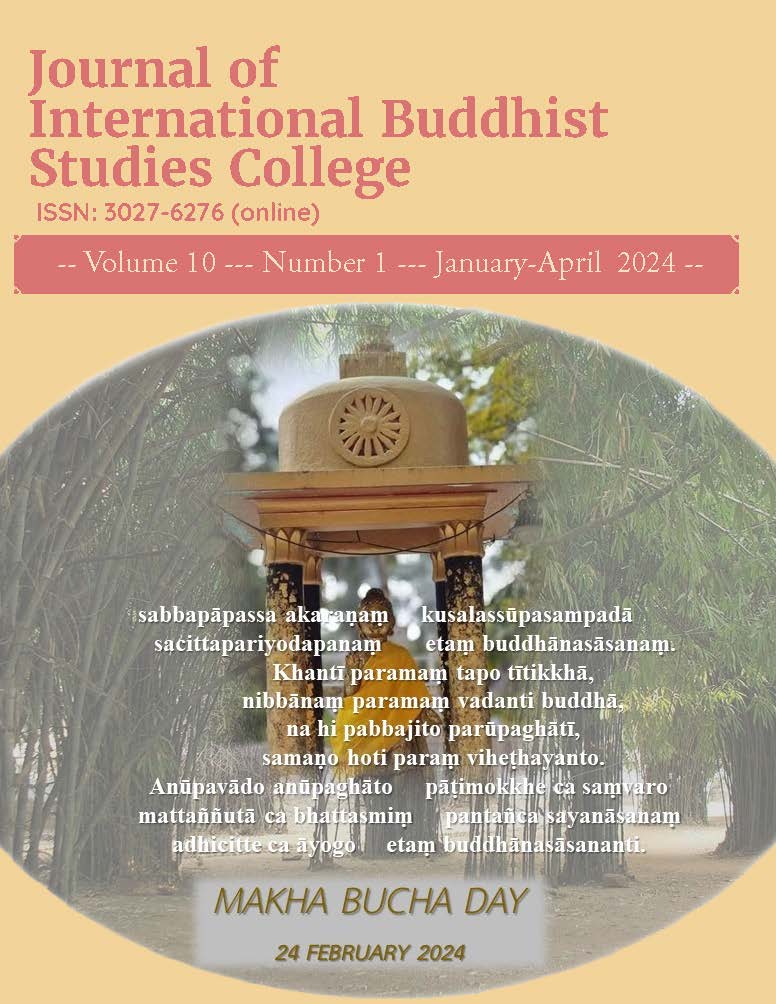Buddhist Guideline for Intercultural Communication in Harmony for Foreign Students of Mahachulalongkornrajavidyalaya University
Main Article Content
Abstract
This study is about how to live harmoniously in a society that includes people of many different races and cultures. This is very important, but how to live harmoniously between different races and cultures has been neglected in previous studies. The objectives of the research are: 1) to explore the coexistence problems of foreign students of Mahachulalongkornrajavidyalaya University (MCU.) 2) to study the rules & regulations for MCU’s foreign students and Buddhist doctrine for living in harmony and 3) to analysis the Buddhist guideline for multicultural living in harmony of foreign students of MCU., The data was obtained from Buddhist doctrine, rule & regulation of MCU. This study explores the Buddhist guidelines for fostering harmonious multicultural living among international students at MCU.
The research findings indicate that the application of Buddha's doctrines, along with the university's meditation program, creates a conducive environment for international students from diverse cultural backgrounds. These guidelines, although beneficial for international students, require active practice to be effective and are also applicable to multicultural societies at large. The primary challenges faced by international students, including disagreements and cultural differences, can be mitigated through the principles of sāraṇīyadhamma, which emphasize conciliation. The study reveals that the successful implementation of these Buddhist principles and regulations hinges on the participants' attitudes. Promoting patience, tolerance, mutual joy, multicultural awareness, social discipline, and dhamma for social life are identified as key components for achieving harmony in a multicultural setting.
Article Details
The Journal of TCI is licensed under a Creative Commons Attribution-NonCommercial-NoDerivatives 4.0 International (CC BY-NC-ND 4.0) licence unless otherwise stated. Please read our Policies page for more information on Open Access, copyright and permissions.
References
Abdul-Rahaman, N., Arkorful, V. E., & Okereke, T. (2022, August). Academic integration in higher education: A review of effective institutional strategies and personal factors. In Frontiers in Education (Vol. 7, p. 856967). Frontiers.
Agoritsas, T., Askie, L., ... & Vandvik, P. O. (2022). A living WHO guideline on drugs for covid-19. British Medical Journal, 370. doi:10.1136/bmj.m3379
Costa, F., & Mariotti, C. (2020). EMI students’“international coexistence” at one Italian university. English-medium instruction and the internationalization of universities,
Feer, L. ed. (1991). Saṃyutta-Nikāya, Part I, Sagātha-Vagga. Pali text society
Horiuchi, T. (2013). An Annotated Translation of Sūtra Passages 62 & 63 in Chapter 2 of the Vyākhyāyukti:“Speaking and Listening” as Means towards the Construction of a Basis for Multicultural Coexistence. Journal of International Philosophy, (2), 355-368.
Jieyi, H., Kiu, C. C., & Baojian, X. (2022). How academic performance influences social integration: The moderation effect of cultural distance among Chinese cross‐borderers. Brain and Behavior, 12(10), e2759.
Kasulis, T.P. (2015). Zen as a Social Ethics of Responsiveness. Journal of Buddhist Ethics, No.13.
Козилова, Л. (2022). Adaptation of foreign students to the conditions of the educations of the educational environment of the university: Problems and prospects. Eurasian Union Scientists, 07-10.
Lackova, L., Kimplova, T., Dueñas, C. P., & Giménez, A. R. (2019). Promoting the development of a resilient personality in a university environment through the practice of mindfulness. In EDULEARN19 Proceedings (pp. 486-492). IATED.
Lee, A. S., Sun, Y., & Chung, K. K. H. (2022). Linking university students’ mindfulness to positive adjustment amidst COVID-19 pandemic: A 6-month cross-lagged panel design. Mindfulness, 13(12), 3080-3090.
Norman, K.R. tr. (1997). Dhammpada: The Word of the Doctrine. Pali text society
Park, K. (2019). Being connected: Academic, social, and linguistic integration of international students (Doctoral dissertation, Purdue University).
Shakirova, A. Y., Nikitina, T. N., & Fatkhullina, L. Z. (2022). Intercultural communication experience of foreign students in the host community. Res Militaris, 12(3), 350-357.
Thongchuay, N., & Suwannual, P. (2017). A., Rochwerg, B., Lamontagne, F., Siemieniuk, R. A., Agoritsas, T., Askie, L., ... & Vandvik, P. O. (2022). A living WHO guideline on drugs for covid-19. British Medical Journal, 370. doi:10.1136/bmj.m3379
Thongchuay, N., & Suwannual, P. (2017). Paradigm of Buddhist peace in different thinking society. Journal of International Buddhist Studies, 8(1).
UYGUR, S. (2022). A look at intercultural sensitivity from the perspective of mindfulness and acceptance of diversity. Journal for the Education of Gifted Young Scientists, 10(4), 547-561.
Ye, S., Xue, H., & Zheng, Y. (2018). A Survey of Intercultural Adaptability for Foreign Students in Three Universities: Problems and Solutions. Theory and Practice in Language Studies, 8(6), 674-680.


